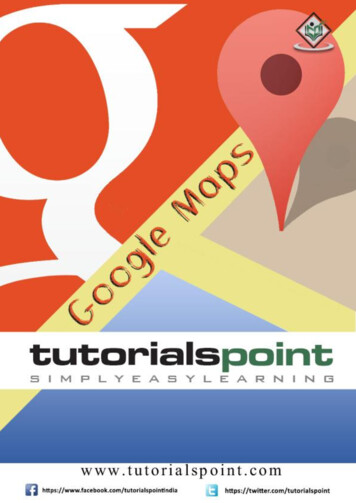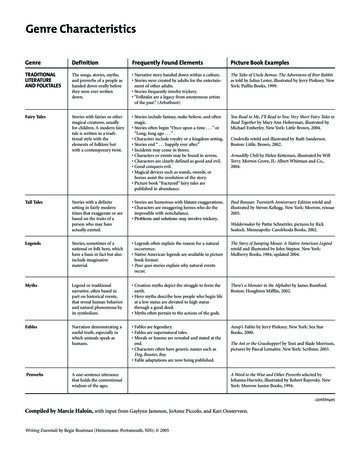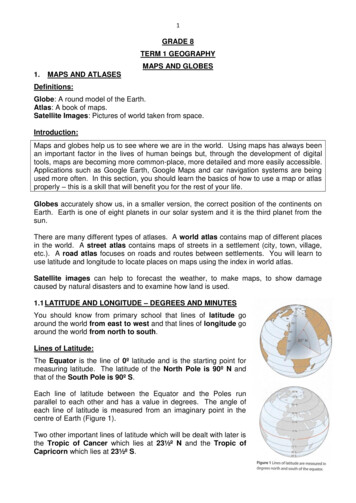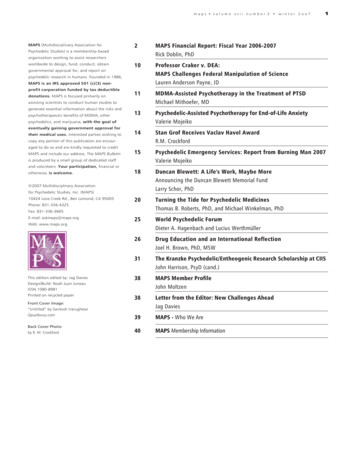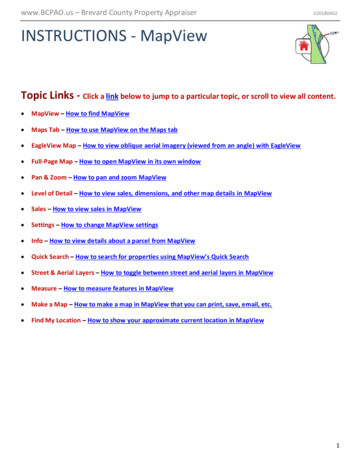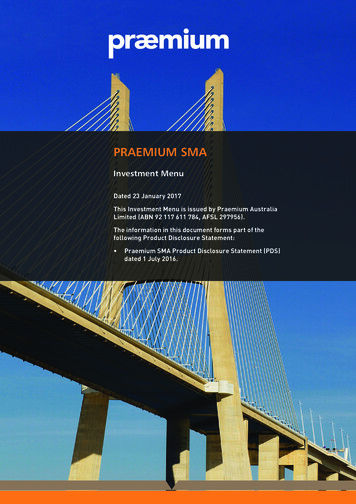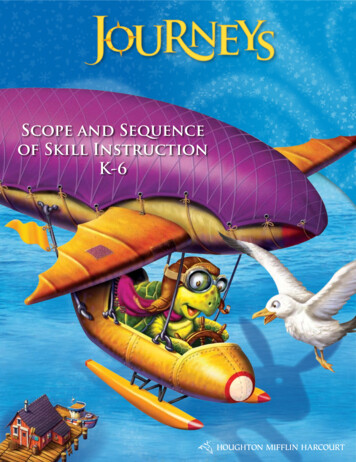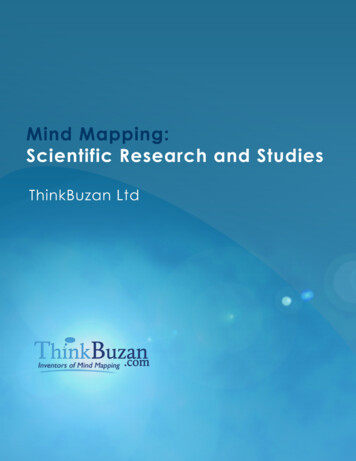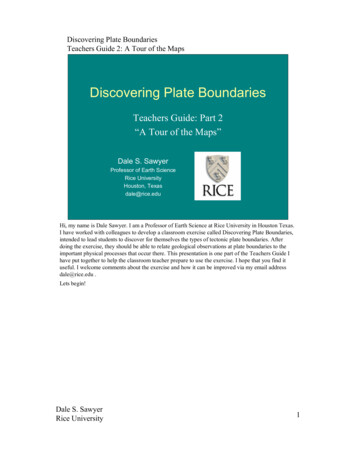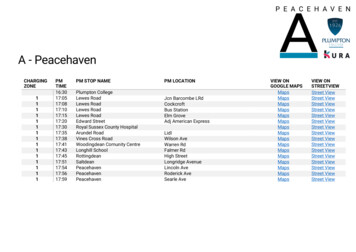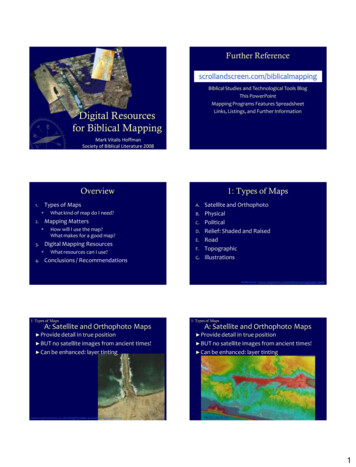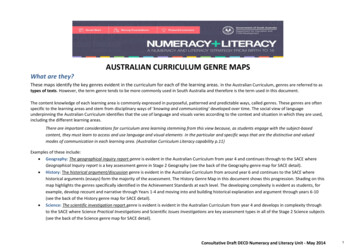
Transcription
AUSTRALIAN CURRICULUM GENRE MAPSWhat are they?These maps identify the key genres evident in the curriculum for each of the learning areas. In the Australian Curriculum, genres are referred to astypes of texts. However, the term genre tends to be more commonly used in South Australia and therefore is the term used in this document.The content knowledge of each learning area is commonly expressed in purposeful, patterned and predictable ways, called genres. These genres are oftenspecific to the learning areas and stem from disciplinary ways of ‘knowing and communicating’ developed over time. The social view of languageunderpinning the Australian Curriculum identifies that the use of language and visuals varies according to the context and situation in which they are used,including the different learning areas.There are important considerations for curriculum area learning stemming from this view because, as students engage with the subject-basedcontent, they must learn to access and use language and visual elements in the particular and specific ways that are the distinctive and valuedmodes of communication in each learning area. (Australian Curriculum Literacy capability p.11)Examples of these include: Geography: The geographical inquiry report genre is evident in the Australian Curriculum from year 4 and continues through to the SACE whereGeographical Inquiry report is a key assessment genre in Stage 2 Geography (see the back of the Geography genre map for SACE detail). History: The historical argument/discussion genre is evident in the Australian Curriculum from around year 6 and continues to the SACE wherehistorical arguments (essays) form the majority of the assessment. The History Genre Map in this document shows this progression. Shading on thismap highlights the genres specifically identified in the Achievement Standards at each level. The developing complexity is evident as students, forexample, develop recount and narrative through Years 1-4 and moving into and building historical explanation and argument through years 6-10(see the back of the History genre map for SACE detail). Science: The scientific investigation report genre is evident is evident in the Australian Curriculum from year 4 and develops in complexity throughto the SACE where Science Practical Investigations and Scientific Issues Investigations are key assessment types in all of the Stage 2 Science subjects(see the back of the Science genre map for SACE detail).Consultative Draft DECD Numeracy and Literacy Unit - May 20141
How have they been developed?The maps have been developed through a process of analysing the content descriptions, achievement standards and scope and sequence of the AustralianCurriculum. In addition, examples of Phase 1 Australian Curriculum subject genres are listed in the Australian Curriculum Literacy capability continuum andthis information has been included into the Science, History and Mathematics genre maps.Overall, only genres clearly identified in the Australian Curriculum have been included. However, the different learning areas vary in their specificity of thekey genres and where key genres have not been specified, examples of possible genres from the content descriptions have been included.How can they be used?These genre maps will provide an invaluable support for whole school, year levels and learning area/faculty planning. They may be adapted and/orextended to more specifically meet the learning needs at each site.Whole School - using TfEL and curriculum requirements as the framework, a genre map enables a school to: think beyond teachers’ individual units of work plan how they will develop the particular and specific ways that are the distinctive and valued modes of communication in each learning area systematically plan for the sequential development of the genres as student progress through the school consider how to use assessment for learning in powerful ways to scaffold success in learning.Year Level Teachers - genre maps support: integration with Learning Design –in particular, What evidence will enable us to assess the intended learning? So what will we do to get there? assessment for and as learning (by focusing teaching on the gap between where a learner is and where they are progressing to the desired goal) systematic and explicit teaching.Learning area/faculties – a genre map supports colleagues to: plan for common assessment tasks to ensure key learning area assessment genres are developed through the years of schooling to enable studentchoices in senior secondary and beyond.English is not included in these genre maps because of the overall focus on ‘text’ and ‘text in context’. Genres are broadly categorises in English asimaginative, informative and persuasive with a focus in the achievement standards each year level on their receptive (comprehending) and productive(composing) modes. Digital Technologies is not included because of limited specificity/identification of genres.Related resources: Professional Learning Modules are available on the Numeracy and Literacy website to support schools. These include: Genres in Primary SchoolsGenres in secondary SchoolsGenre MappingPlease forward any feedback/comments regarding this draft document to to Nanette.smibert@sa.gov.auConsultative Draft DECD Numeracy and Literacy Unit - May 20142
CONTENTSAustralian Curriculum:Mathematics GenresP. 5Science GenresP. 7History GenresP. 9Geography GenresP. 11Civics and citizenship GenresP. 13Economics and Business GenresP. 15The Arts GenresP. 17Design and Technologies Genres (Digital Technologies not included)P. 19Health and Physical Education GenresP. 21Literacy Capability Summary Companion DocumentP. 23Consultative Draft DECD Numeracy and Literacy Unit - May 20143
AUSTRALIAN CURRICULUM MATHEMATICS GENRESDeveloped from the Literacy Capability Maths text examples pp 24-25 with reference to the Mathematics contentdescriptions, achievement standards, scope and sequenceLevel 1eLevel 2Level 3Typically by the endof Foundation YearTypically by theend of Yr 2Typically by the end ofYr 4Describe PatternsReports ofsteps in aprocessReports of a processe.g converting mixedWord problemse.g. Multiplication anddivisione.g. materials, sounds,movements ordrawingse.g. conducting achance experimentnumbers to improperfractions and vice versaLevel 4Typically by the end of Yr 6Level 5Level 6Typically by the end ofYr 8Typically by the end of Year 10ProceduresProceduresProcedureseg. how to make mathematicalshapes or complete a processhow to complete amathematical task orprocesshow to complete a mathematicaltask or processWord problemsWord problemsWord problemse.g. addition and subtractionof fractionse.g. involving profit or losse.g. involving algebraic equationsProcedureseg. how to makemathematical shapes orcomplete a processSimplestatements ofcomparisone.g. in relation to mass,length and capacityWordproblemse.g. addition andsubtractionDays of the weekMapsMapsExplanationExplanationExplanatione.g. to connect orderand eventse.g. to receive andgive information orto describe placee.g. use scale to describethe difference in a city inAustralia and Indonesiaof mathematical processesof mathematical processesof mathematical processesYes/no questionsQuestionsto collect informationto collect dataSurveys - questionsand recordingSurveys - questionsand reportsSurveys - questionsand reportsSurveys - questions andreportsData displaysData displaysData displaysData displaysData displaysData displayse.g. representingresponses to questionsposede.g. picture graphsto represent one-toonecorrespondencee.g. to represent the mostpopular breakfast cereal inthe classwith and without digitaltechnologiese.g. as part of an investigationinto representations in themediawith and without digitaltechnologiese.g. as part of aninvestigation into randomsamplingwith and without digitaltechnologiese.g. use parallel box plots tocompare and interpret data aboutthe age distribution of ATSI peoplewith that of the Australianpopulation as a wholeReports of grouptasksRecounts andevaluations of grouptasksRecounts andevaluations ofgroup tasksRecounts and evaluationsof group taskse.g investigationse.g investigationsCalendarse.g. use to locatepersonally or culturallyspecific dayse.g. oral or writteninvestigationsConsultative draft from Numeracy and Literacy Unit, April 2014e.g investigations5
SENIOR SECONDARY: SACE MATHEMATICSSACE Stage 1Mathematics/Mathematical Applications/MathematicsPathwaysAssessment TypesAssessment Type 1: Skills and Applications Tasks SACE Stage 2Mathematical Studies/Mathematical Methods/ MathematicalApplications/Mathematical PathwaysAssessment TypesAssessment Type 1: Skills and Applications Taskssolutions to mathematical questions/problemsin written form or in the form of numerical data, diagrams, tables, or graphsAssessment Type 2: Folio: Mathematical investigations interpret and justify results, summarise, and draw conclusions appropriate explanations and arguments in a report including: an introduction that outlines the problem to be explored, including its significance, its features, and the contextthe method required to find a solution, in terms of the mathematicalmodel or strategy to be usedthe appropriate application of the mathematical model or strategy,including– the generation or collection of relevant data and/orinformation, with details of the process of collection– mathematical calculations and results, and appropriaterepresentations– the analysis and interpretation of results– reference to the limitations of the original problema statement of the results and conclusions in the context of the originalproblemappendices and a bibliography, as appropriate.Assessment Type 2: Folio: Mathematical investigations interpret and justify results, summarise, and draw conclusions appropriate explanations and arguments in a report including: an introduction that outlines the problem to be explored, including itssignificance, its features, and the context the method required to find a solution, in terms of the mathematicalmodel or strategy to be used the appropriate application of the mathematical model or strategy,including– the generation or collection of relevant data and/orinformation, with details of the process of collection– mathematical calculations and results, and appropriaterepresentations– the analysis and interpretation of results– reference to the limitations of the original problem a statement of the results and conclusions in the context of the originalproblem appendices and a bibliography, as appropriate.Assessment Type 3: Examination(Mathematical Pathways has no examination - instead the subject requiresan externally marked Investigation)Performance standards Mathematical knowledge and skills and theirapplication Mathematical modeling and problem solving Communication of mathematical information6
AUSTRALIAN CURRICULUM SCIENCE GENRESDeveloped from Science content descriptions, achievement standards, scope and sequenceand the Literacy Capability pp 24-25Level 1eLevel 2Typically by the endof Foundation YearTypically by the endof Yr 2Level 3Topic example:Topic example:Topic example:Topic example:Topic example:Topic example:The weatherMaterialsLiving thingsChanges to materialsEnergyDNA and genesTypically by the end ofYr 4Level 4Typically by the end ofYr 6Level 5Typically by the end of Yr 8Questions andanswersProceduresProceduresProcedurese.g. How to make papere.g. How to set up a wormfarme.g. How to measure theeffect of oxygen on steel.e.g. How to set up a light globeexperimentStatements ofobservationsDescriptions ofobservationsDescriptionsInformation reportsInformation reportsInvestigative reportsInvestigative reportse.g. questions to guideobservations of weatheracross a terme.g. How the ants in ourgarden respond todifferent weathere.g property ofmaterialsof observed objects, livingthings or phenomenae.g The physical properties ofnatural materials in ourgardenusing multi-source researche.g Recyclable materialsLevel 6Typically by the end of Year 10Proceduresusing multi-source researche.g Different types of kineticenergyInformation reports usingmulti-source researche.g How chromosomes came to berecognised as the carriers of genesInformation reportse.g. Feral predators in ourareaDrawings torepresent ideasAnnotateddiagramse.g. illustrations toaccompany observationof antse.g. From tree to eggcartonAnnotated diagramsthat illustrate relationships orprocessese.g. The lifecycle of a froge.g. Effects of heating andcooling metalsInvestigative reports(individual and group investigations)e.g. exploring family trees withinherited characteristics ORexploring patterns of phylogenetictrees including extinctions and causesfor these that are related to naturalselectionCausal explanationsTheoretical multimodalexplanationse.g. How plants provideshelter for animalsSequentialexplanationse.g.From tree to egg cartonCausal explanationse.g. How fire affects seedgerminationCausal explanationse.g. How oxygen affects steelInvestigative reports(individual and groupinvestigations)e.g. Which light globe uses leastenergy ?with supporting evidencee.g. The effect of greenhousegases on the earth’s energyPersuasive textsto argue for a particular course ofactione.g. Why we should use publictransport or to discuss both sidesof a contentious issue e.g. Shouldwe use nuclear energy inAustralia?e.g. Factors that cause mutations andtheir causesArgumentsbased on evidence, using appropriatescientific language e.g. The impact ofIVF on natural selectionDiscussion textswith supporting evidence to present apoint of view on a contentious issuee.g. Genetic modification and worldfood security: a discussionConsultative draft from Numeracy and Literacy Unit, April 20147
Australian Curriculum Science: Curriculum focus(biological science, chemical science, earth and space science, physical science)F- Yr 2Yrs 3-6Awareness of self and the local worldYrs 7-10Recognising questions that can be investigatedscientifically and investigating themExplaining phenomena involving science at its applicationsSENIOR SECONDARY: SACE SCIENCES (Biology, Chemistry, Physics, Geology)SACE Stage 1Assessment TypesSACE Stage 2Assessment TypesAssessment Type 1: Investigations FolioAssessment Type 1: Investigations Folio (40%)Assessment Type 2: Skills and Applications TasksAssessment Type 2: Skills and Applications Tasks (30%)Practical InvestigationsIssues InvestigationField Investigation (Geology)Skills and applications tasks require students to use their knowledge andunderstanding of relevant ideas, facts, and relationships in a range of tasks(NB range of purposes/genres)Practical InvestigationsIssues InvestigationField Investigation (Geology)Skills and applications tasks require students to use their knowledge andunderstanding of relevant ideas, facts, and relationships in a range of tasks(NB range of purposes/genres)Assessment Type 3: Examination (30%)Students undertake one 3-hour examination (e.g. multiple choice, causal andtheoretical explanations –stand-alone paragraphs and extended texts)Performance standards investigation analysis and evaluation application knowledge and understanding.8
AUSTRALIAN CURRICULUM HISTORY GENRESDeveloped from History content descriptions, achievement standards, scope and sequence and the Literacy Capabilitypp 24-25Level 1eLevel 2Level 3Level 4Level 5Level 6Typically by theend of FoundationYearTypically by theend of Yr 2Typically by theend of Yr 4Typically by the end of Yr 6Typically by the end of Yr 8Typically by the end of Year 10Personal andfamily historiesYr 1: Present andpast family lifeYr 2: The Past inthe present – localhistoryYr 3:Community andremembranceYr 4: FirstcontactsYr 5: The AustraliancoloniesYr 6: Australia as a nationYr 7:The Ancient WorldYr 8: The ancient to themodern worldsimplesequences of historical historicalretellings of an recounts of anhistorical recounts of a historical recounts of a familiar objects/eventse.g. a visual timelineof key events/stagesin my life so farnarrativesabout the past e.g.retell the story of asignificant day formy family questionsand answerse.g. interviewgrandparents aboutwhere they wereborn and raisedevente.g. when the bridgewas built in our town narratives builtaround historicalevents/peoplee.g. a significantperson that changedour community descriptionsof historicalpeople and placese.g. the Ngarrindjerisites in the areaevente.g. the journeys ofChristopher Columbus and contact withindigenous peoples historicalnarratives told series of events with somesummative commentarye.g. the story of Federation historical narratives thatfrom a particularperspectiveretell past events, for examplefrom a particular personal orcultural perspective descriptions detailed descriptions ofe.g. a diary of aconvict on the FirstFleetof a historicalfigure or placee.g. significance ofthe old gum tree,Glenelge.g the experiences of a post-warmigrant family - their cultural practicesand those existing in Australia at thetimeparticular places from the pastdemonstrating use of sourcemateriale.g. the Goodwood Orphanage explanation of cause andeffect of change in societye.g. Aboriginal life before and aftercolonisation persuasive texts, forexample presenting a particularpoint of view in relation to anhistorical event or figuree.g. Discuss the role of Australiansuffragettes in changing AustraliandemocracyConsultative draft Numeracy and Literacy Unit April 2014series of events with somesummative commentaryYr 9: The making of the modernworldYr 10: The modern world andAustralia historical recounts of a seriesof events or developments within achronological framework with somesummative or evaluative commentarye.g. the building of the pyramids atGizae.g the events of the Freedom Rides inthe 1960s and their impact on Australiansociety. historical narratives thatretell past events, for examplefrom a particular personal orcultural perspectivee.g. the story of Confucius in ancientChinese history detailed descriptions, forexample of particular (events,people and ) places form thepast demonstrating use ofevidence from sourcese.g. the water management systemat Angkor explanations that, forexample, present the causes ofan event detailed descriptions, forexample of particular (events, peopleand) places form the pastdemonstrating use of evidence fromprimary and secondary sources, usingappropriate referencing eg the Boxer rebellion in China explanations that, for example,consider past events from a particularpersonal or cultural perspectivee.g. the role of the Mongols inforging connections between Europeand Asia. discussion texts withsupporting evidencee.g. Discuss the impact on theWestern world of inventions anddevelopments in the Islamic worldSee the p.1 Introduction for an explanation of the shading on this mape.g. the role of the industrial revolution onthe transatlantic slave trade discussion texts, that forexample, present historicalarguments with supporting evidence.e.g. Post World War 2 migrationfundamentally changed Australian society.Discuss.9
Australian Curriculum History: Development of concepts for developing historical understandingF-Yr 2Yrs 3-6Yrs 7-10Time continuity and changeTime continuity and changeTime continuity and changeCause and effectCause and effectCause and ives and empathyPerspectives and empathyEvidence and contestabilitySACE History Performance standardsSENIOR SECONDARY: SACE HISTORYSACE Stage 1 HistoryAssessment TypesSACE Stage 2 HistoryAssessment TypesFolioFolio (50%)eg. historical reports, research assignments, debates, scripted role plays, hyperlinkeddatabases and maps, interviews, excursion reports, oral presentations, web pages, essays,multimodal presentations.eg. historical reports, research assignments, debates, scripted role plays, hyperlinkeddatabases and maps, interviews, excursion reports, oral presentations, web pages,essays, multimodal presentations.Source analysisEssay (20%)use, interpret, evaluate, and reflect on a selection of different historical sources; todemonstrate historical interpretation skills in relation to historical context, authenticity, bias,reliability, audience, limitations, and usefulnessan informed, sequenced, reasoned, and persuasive historical argument in response tothe hypothesis and/or focusing question(s).Investigation (in depth historical inquiry)Examination (30%)inquire into, interpret, and research a historical topic in depth2 essays and 1 source analysis knowledge and understanding inquiry and analysis reflection and evaluation communication10
AUSTRALIAN CURRICULUM GEOGRAPHY GENRESDeveloped from Geography content descriptions, achievement standards, scope and sequenceLevel 1eLevel 2Typically by the endof Foundation YearTypically by the end ofYr 2Typically by the end of Yr 4Yr 1: Places havedistinctive featuresYr 3: Places are bothsimilar and differentYr 2: People areconnected to manyplacesYr 4: The earth’senvironment sustainsall lifePeople live inplacesLevel 3Level 4Typically by the end of Yr 6Yr 7: Water in theWorld; Place andliveabilityYr 9: Biomes and foodsecurity; Geographies ofinterconnectionsYr 6: A diverse andconnected worldYr 8: Landforms andlandscapes; ChangingnationsYr 10: Environmentalchange and management;Geographies of humanwellbeing Description Description Descriptione.g features of aspecial placee.g the connections oflocal indigenous peopleto land, sea, animals oftheir placee.g different ways of managingwaste sustainablyeg differences in population size,density, life expectancy, percapita income of countries Explanation ExplanationRepresentatione.g story-map toshow location offeatures from classstory Datarepresentatione.g a table to show theconnections whichstudents in the classhave to different placesLevel 6Typically by the end of Year 10Yr 5: Factors that shape thehuman and environmentalcharacteristics of places Descriptione.g explain the differencesbetween climate and weatherLevel 5Typically by the end of Yr 8e.g. explain why sustainabilityis important Explanation Explanatione.g. explain reasons for andeffects of internal migration inChinae.g causal explanation: thechallenges to global foodproduction Data representation Data representation Data representation e.g. tables and graphs to showtypes of vegetation in Australiaand selected countries of Africaor South Americae.g. flow map to showconnections Australia has withselected Asian countriese.g use ABS census data tomap Australia’s demographicfeatures using spatialtechnologies softwaree.g use spatial technologiessoftware to create a map showingrelationship between biomes andworld food production Persuasive Persuasivee.g. Discuss arguments forand against a more balanceddistribution of the urbanpopulatione.g. NGOs play a key role inimproving human andenvironmental wellbeinginternationally . DiscussData representationGeographical Inquiry Report:becomes an increasingly complex macro-genre as students progress through school(e.g inquiry question, representation of data, explanation and evaluation of data, analysis and discussion of findings, proposal for action) Report Inquiry Report Inquiry Report Inquiry Report Inquiry Report:e.g. how people’sconnections with placesare affected by transportand ICTse.g how Aboriginal/ATSI peopleadapted to the resources oftheir country – desert, coastal,alpine, riverine, locale.g. the impact of bushfire oncommunities and environmentsand how people can responde.g. field report – comparisonof 2 local government stormwater catchment projectsand proposal for extensione.g. The change andmanagement of marineenvironments in Australia andIndonesia Oral Reflection Oral Reflection Proposal for action Proposal for action Proposal for actionEvaluation and Proposale.g reflect on learningto suggest ways to lookafter a placee.g. reflect on learning tosuggest significance ofconnections with placese.g. to promote awareness onreducing impact onenvironmente.g included in inquiry abovee.g included in inquiryabovee.g. included in inquiry above11
Consultative draft Numeracy and Literacy April 2014SENIOR SECONDARY: SACE GEOGRAPHY ASSESSMENTSACE Stage 1 GeographyAssessment TypesSACE Stage 2 GeographyAssessment TypesAssessment Type 1: Skills and Applications TasksAssessment Type 1: Fieldwork (25%)Students demonstrate understanding of geographical concepts using a range ofskills related to fieldwork, the evaluation of primary and secondary sources, and/orthe reporting of information.Students undertake one report on their individual fieldwork relating to one ofthe option topics. The selected option topic must differ from that used for theinquiry (see below). Each student is responsible for independently planning,organising, and carrying out fieldwork and completing a report.Assessment Type 2: InquiryAssessment Type 2: Inquiry (20%)Students undertake a spatial inquiry that uses GIS principles and skills to capture,manage, manipulate, and analyse data and create a map-based data display.Students initiate and carry out one inquiry into a particular issue addressed inan option topic. The selected option topic must differ from that used for thefieldwork report (see above). The inquiry must involve the study of an issuethat has local, national, and global relevance.Assessment Type 3: FieldworkAssessment Type 3: Folio (25%)Students undertake fieldwork in which they apply the skills of geographicalinterpretation. Students make observations and record data in the field, andidentify, select, and critically analyse the field data.Students undertake a planned program of four to six group and individualassessments for the folio.Assessment Type 4: InvestigationAssessment Type 4: Examination (30%)Students investigate a contemporary geographical issue. Students investigate anissue in its geographical context by collecting, analysing, and commenting onprimary and secondary data and information.Skills assessed are those associated with the use and interpretation ofgeographical data and information, including maps, as described in the‘Content’ section. The examination consists of short-answer and extendedanswer questions on knowledge, skills, and analysis of data.12
AUSTRALIAN CURRICULUM CIVICS AND CITIZENSHIP GENRESDeveloped from the Civics and Citizenship content descriptions, achievement standards, scope and sequenceYear 3 and Year 4Year 5 and Year 6Year 7 and Year 8Year 9 and Year 10Example questions: How aredecisionsmadedemocratically? Why do wemake rules? How can local What is democracygovernmentin Australia/ why iscontribute tovoting important?community life? How do laws affect What is the difference the lives of citizens?between rules andlaws? What are the rolesand responsibilitiesof the different levelsof government? What does it meansto be an Australiancitizen? How is Australia’s What are thedemocratic systemfreedoms andof gov’t shaped byresponsibilities ofthe constitution?citizens in ourdemocracy? How is Australia adiverse society and How are laws madewhat factorsand applied incontribute to aAustralia?cohesive society? How does ourcourt system workin support of ademocratic /justsociety? How do citizensparticipate in aninterconnectedworld? How is Australia’sdemocracy definedand shaped by theglobal context? What are thefeatures of aresilientdemocracy?The following genres should be situated and explicitly taught in the context of the Civic and Citizenship skills/research process outlined in the curriculum (see examplequestions above): develop/pose questions gather information and data (in the middle years this may include conducting surveys and opinion polls) synthesise/critically analyse/interpret information develop point of view after examining all perspectives undertake (informed) collaborative problem solving present position (using subject-specific language) develop plan of actionDescriptionDescriptioneg. describe the different beliefs,traditions and symbols used by groupseg. describe the roles and responsibilitiesof the three levels of tioneg. explain the purpose of localgovernment (oral presentation usingvisual support such as charts, maps)eg. explain the importance of theWestminster system and the Magna Cartain influencing Australia’s parliamentarygovernmenteg. explain the factors influencing thechange in trends regarding religiousobservance in Australian society based onABS and other data sourceseg. explain how international conventionshave shaped Australian governmentpolicies with regard to Aboriginal andTorres Strait Islander PeoplesArgumentArgumentArgumentArgumenteg. present ideas and opinions on theconsequences for breaking school rules(using civics and citizenshipterminology)eg. present a position on theresponsibilities associated with Australiancitizenshipeg. argue the case for a constitutionalchange(using digital technologies)eg. argue how Australia should continueto sustain a resilient democracyConsultative draft Numeracy and Literacy Unit April 201413
AUSTRALIAN CURRICULUM ECONOMICS AND BUSINESS GENRESDeveloped from Economics and Business content descriptions, achievement standards, scope and sequenceYear 5 and Year 6Year 7 and Year 8Year 9 and Year 10Examples of Year level Framework Questions: Why do I have tomake choices asa consumer?What influencesthe decisions Imake?What can I do tomake informeddecisions? What are the possible effectsof my consumer and financialchoices? Why do businesses exist andwhat are the different waysthey provide goods andservices? Why is there arelationship betweenconsumers andproducers in themarket? What types of workexist and what otherways can peoplederive an income? What are markets neededand why are governmentsinvolved? Why do consumers andbusinesses have both rightsand responsibilities? How do participants in theglobal market interact? How does creating
Maps e.g. to receive and give information or to describe place Maps e.g. use scale to describe the difference in a city in Australia and Indonesia Explanation of mathematical processes Explanation of mathematical processes Explanation of mathematical processes Calendars e.g. use to locate personally or culturally specific days Yes/no questions
